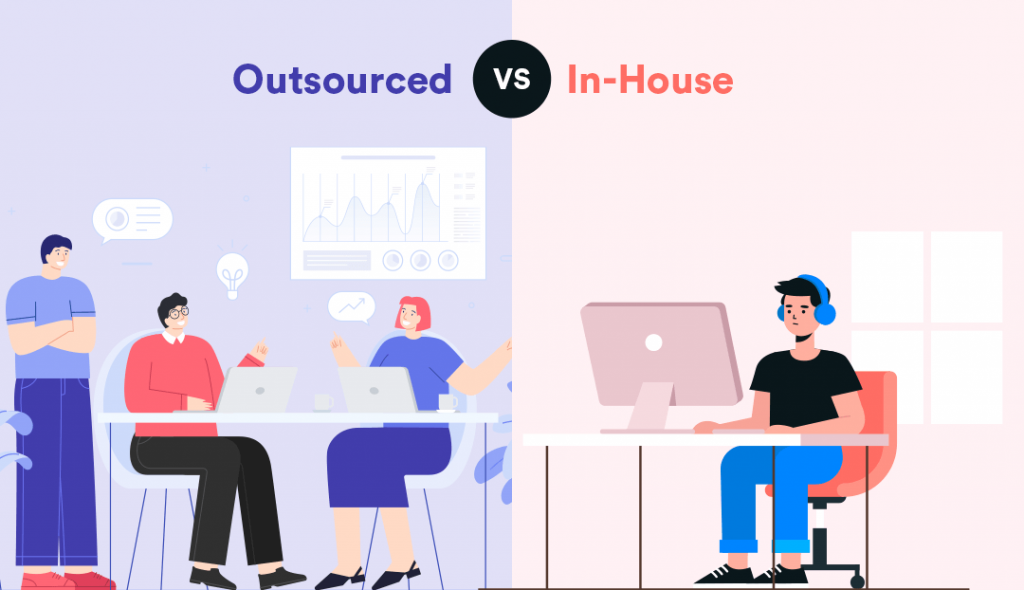Developing digital products is not a cakewalk. Whether you are an enterprise or a startup that is looking for development opportunities. It requires a lot of decision-making before you can get started. One such decision-making involves what to choose when it comes to in-house development vs outsourcing.
Are you stuck on this decision too? Well, today we are going to discuss everything that matters while deciding the right choice for your business when it comes to in-house development vs outsourcing.
So, without further ado, let’s get started!
Do you Understand the Exact Meaning of In-House Development?
If you are a tech enthusiast, certainly you do! In case not, then in-house development is the process of building your digital assets by utilizing your company-owned resources. By resources, we mean designers, developers, testers, software, hardware support, etc.
In-house development is developing software with the help of experts and resources you have within your organization. All the employees or developers work according to the tasks assigned by you.
In-house development is often called insourcing. Choosing in-house development is just like hiring permanent staff in your organization. For in-house development, one needs to first follow the recruitment process and take interviews to build the team.
The in-house development works fairly as the success or failure of the in-house development team will depend on your leadership.
It allows the employees to have a better knowledge of how the business works overall by analyzing the insights of the activities and how to control them.
When to Use In-House Development?
When you are planning a long-term development project including enough budget, hiring an in-house team will be beneficial to your business. The benefit of growing an in-house development team is that it provides full control of the overall organization and project management within the team.
While dealing with customers, the firm keeps its entire services and transactions in-house. In-house financing has become common in various industries. The in-house financing works by using the firm’s resources to extend the customer’s loan allowing them to purchase its goods and services.
Steps for Successful Insourcing
Whenever a project comes, with the right knowledge and management skills, the professionals and their experience will benefit your organization by choosing the right process for your business role model.
Some of the tips for establishing a successful insourcing are:
- Share the vision of your business model.
- Business clarity goes a long way.
- Determining the resources to recruit and hire the employees is required to build the product.
- A development team requires at least 7 professionals, a product manager, a designer, 2 developers, an engineer, and a user interface designer.
- Hiring these required professionals requires a lot of time and effort. These professionals will control every detail of the software project.
- Implementing the performance structure.
- Focus on managing it in the right way.
The 3 elements of insourcing are people, processes, and technology. This can affect whether an insourcing process succeeds or fails.
To understand more about the in-house development process, here are some pros and cons which will help you better in choosing between insourcing and outsourcing.
Advantages of In-House Development
- Full Control: The company has full control over the system, products, and employees which allows you to differentiate from the competitors. The employees are motivated and pay more attention to functionality.
- Communication: The in-house developers work directly with your organization face-to-face. It becomes easier to communicate and to create new features to make the project. The advantage is that they share the same language which helps in collaborating more easily. haring fixed working hours, face-to-face meetings, and the required feedback results in a productive team.
- Involvement in a Team Structure: Insourcing allows you in picking the right employee for the organization which requires more time and effort in finding the right person for the role. The involvement of the team results in quick changes whenever required.
Disadvantages of In-House Development

- High Cost: The maintenance of the salary and benefits of the development team. The higher the number of members of the development team, the higher will be the cost to execute the project. In-house development will cost 2-3 times more than outsourcing. The cost is dependent on hardware, software, rent, and taxes.
- Staff Turnover: There is a higher demand for skilled and professional developers in the market. You need to spend resources and funds while hiring skilled developers so that they will not leave their current role in your organization as many companies offer higher salaries.
- Work Overload and Time-Consuming: Work pressure will result in poor performance of the project. With the new technologies and tools, your team needs to ensure quick changes. Also, finding new employees will be time-consuming as you have to start investing and training again to reach the desired goal.
Today, the world is taking a different approach. Rather than building in-house teams, businesses now prefer to build remote tech teams.
Having difficulty managing your project? Read our guide on how to handle project management to make your workspace smooth.
What is Outsourcing?
Outsourcing is a practice where you provide a project in a shared responsibility to a third or external party to handle its software development projects instead of using in-house resources. Outsourcing is a faster and more cost-effective way than in-house development.
Nowadays both small and large companies are using outsourcing as it eliminates the need to spend time on the recruitment process. With the help of outsourcing, the system allows you to create big projects that are economically profitable to your business.
Some of the benefits of outsourcing are increasing productivity, improving the quality of products, reducing the risks of expansion of business, capitalizing on advanced technologies, and reducing costs.
Still unable to choose between outsourcing vs offshoring development? Read our guide on outsourcing vs offshoring to gain in-depth insights.
When to Use Outsourcing Development?
Choosing to outsource development is a better option when your company faces situations like:
- Fix the budget or when your company is not in a position to afford a specific team
- Lack of skilled employees as spending money on outsourcing will be better than training the employees for months
Outsourcing software development allows the team to focus on growth and innovation. The outsourcing services include developing commercial software for customers and developing custom software your company uses.
Steps for Successful Outsourcing
- Identify what exactly you need; app type, platforms to run your app, estimated deadlines, etc.
- Collaborating with a reputable outsourcing partner by checking out their expertise, and certifications.
- Creating deadlines for completion of work/projects.
- It is important to review the progress regularly.
- It is important to find out the expected quality results and services that the third party is providing.
Advantages of Outsourcing
Outsourcing helps in making your business more flexible, able to change as per market trends, and provides cost savings and service level improvements.
Some of the Advantages of Outsourcing are:
- Increased Efficiency: Collaborating with a company that specializes in the service you need can help in achieving efficiency.
- Focus on Business Activities: Outsourcing can help your business to focus on its strength and help the employees to work on particular tasks and strategies for future growth.
- Saving Costs and Time: Finding and onboarding a new employee for your organization takes a lot of time. So it’s better to work with an outsourcing partner that can take care of the recruitment process.
Disadvantages of Outsourcing

Despite the advantages of outsourcing, here are some disadvantages too as follows:
- Miscommunication: One of the biggest challenges with outsourcing comes along in the way of expectations mismatch, sometimes due to a lack of project clarity or poor communication skills.
- Quality: Another reason that companies avoid outsourcing is the fear of getting end products of low quality.
Facing communication issues with outsourcing development? Read our guide on challenges faced by developers and how to resolve them to make your project run smoothly.
In-House vs Outsourcing Development
In-house development is a practice where the company builds its team and uses its valuable skills to create the software. Whereas Outsourcing is the practice of working with an external company of skilled employees to develop the project quickly and efficiently.
As you have read the advantages and disadvantages of both processes, here is a brief in-house development vs outsourcing comparison.
| In-house Development | Outsourcing Development |
| Quality depends upon your leadership and skills set of the tech team | Quality of services and coding depends on your technology partner |
| The scope of innovation & scalability is low | It is easy to scale both the project & team and drive innovation |
| Building digital products in-house provide better control and coordination | With a team-oriented approach, you can lead your external team the way you want |
| Communication and transparency becomes the key strength in overall project success | With the effective use of technology, it is possible to deal with communication issues |
| The cost of building digital products in house is usually very high | Outsourcing enables you to build high-quality digital products at 1/4th cost |
Final words
While making the right decision for your business always ask yourself what your business needs. In order to find out the solution to this question, you must know the clear requirements and needs.
As we have read about the benefits of in-house development vs outsourcing, we can agree that there are pros and cons to both these. Depending on your business, make sure you choose the right solution to run your business efficiently.
If you have enough budget, then you should go for in-house development. And if you want to start with outsourcing, the best thing to begin is assigning small projects to them to meet the expected requirements.
Unable to find expert tech staff for your mobile app project? Hire a team of developers from Applify that will help you build a market-fit mobile app.









